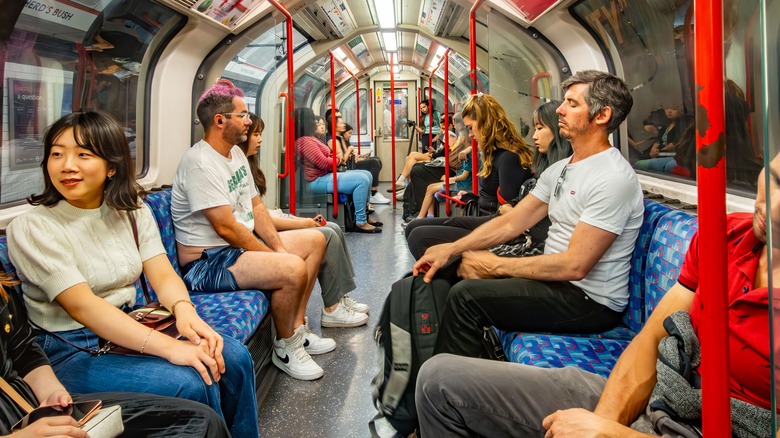The Unsettling Reason You May Want To Avoid The London Underground's Northern Line
London is rarely thought of as a mega-city with dangerous pollution levels like those in other parts of the world. Still, the air quality in some areas of the U.K. capital can be questionable, including in the city's underground train system. Transport for London (TfL) commissioned a study of dust levels in Tube stations and found the Northern line to have the most respirable dust (per the BBC), a type of micro dust that can settle deep in the lungs, potentially causing respiratory conditions and diseases.
The Northern Underground line is known to be busy, spanning 50 stations and carrying a whopping 225,000 passengers during evening rush hour times. There's a good chance you'll use the line during your London vacation to reach stops like Waterloo, Leicester Square, and Camden Town. Unfortunately, because the Northern line has some of the deepest stations beneath the ground, ventilation can be poor.
The dust measured in the study is largely the result of metals scraping together on the tracks and train car wheels. As trains come barreling down the tracks, grinding to a halt at each station, iron sediment forms, which can be inhaled by train passengers. The particles can also be made up of skin cells, hair, and other minuscule matter, similar to the dust found in your home.
Is the dust on the Tube really that bad?
You don't need to swear off the London Underground and its Northern line completely, as Tube dust isn't always as bad as it sounds. For one, TfL has stated that levels of microscopic dust particles have been on the decline across the city's Tube network. Therefore, even if the Northern line is currently ranked the worst, it's better than it hass been in the past.
Moreover, the amount of respirable dust found along the train tracks isn't thought to be dangerous. The Greater London Authority notes on its website that the dust in the underground stations always remains below the legal limit set by regulators. Even still, the government continues to monitor Tube dust levels and tidy up stations that have been found to be especially polluted.
The Greater London Authority also argues that avoiding the London Underground and opting for above-ground modes of transport isn't a logical swap, given the nitrogen dioxide and vehicle exhaust contaminating the air on the streets. It also adds that there's no evidence (yet, at least) that Tube dust is linked to cancer. With this in mind, it's up to your discretion whether it's worth limiting your time on the Tube.
How to protect yourself from Tube dust in London
Exploring on foot and hopping on double decker buses are both great ways to see London while avoiding the dusty Tube stations. However, if you do decide to use the trains to get around, consider taking precautions to protect your lungs. First, try to limit the time you spend underground, especially on trains that are deep beneath ground level. Stick to above-ground lines when possible, and get off a stop or two before your destination, walking the remainder of the way.
Along with your usual list of must-download apps for your trip to London, make sure to install CAIR London on your Apple or Android phone. The app is designed to help you navigate London using the least polluted train routes (as well as the quietest, in case the sound of screeching wheels stresses you out). You may also want to keep a face mask in your travel bag. N95 (FFP2 in Europe) masks filter out tiny particles, including Tube dust, and can be a useful tool for travelers with asthma and other respiratory conditions.


